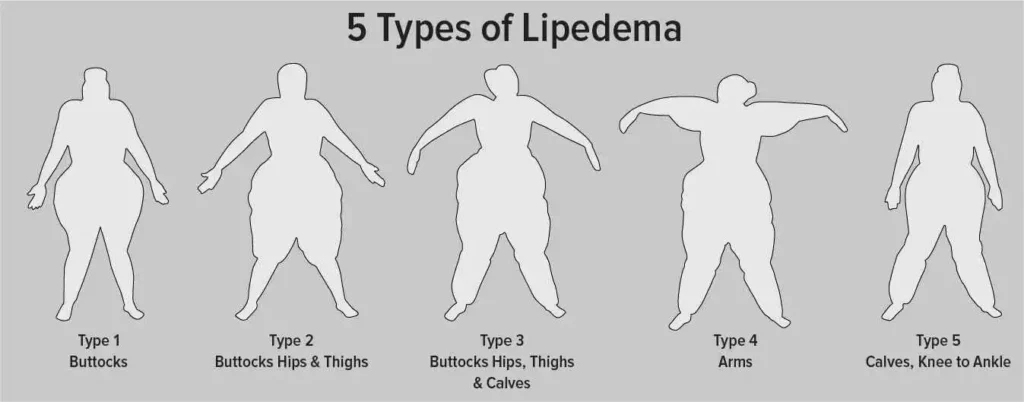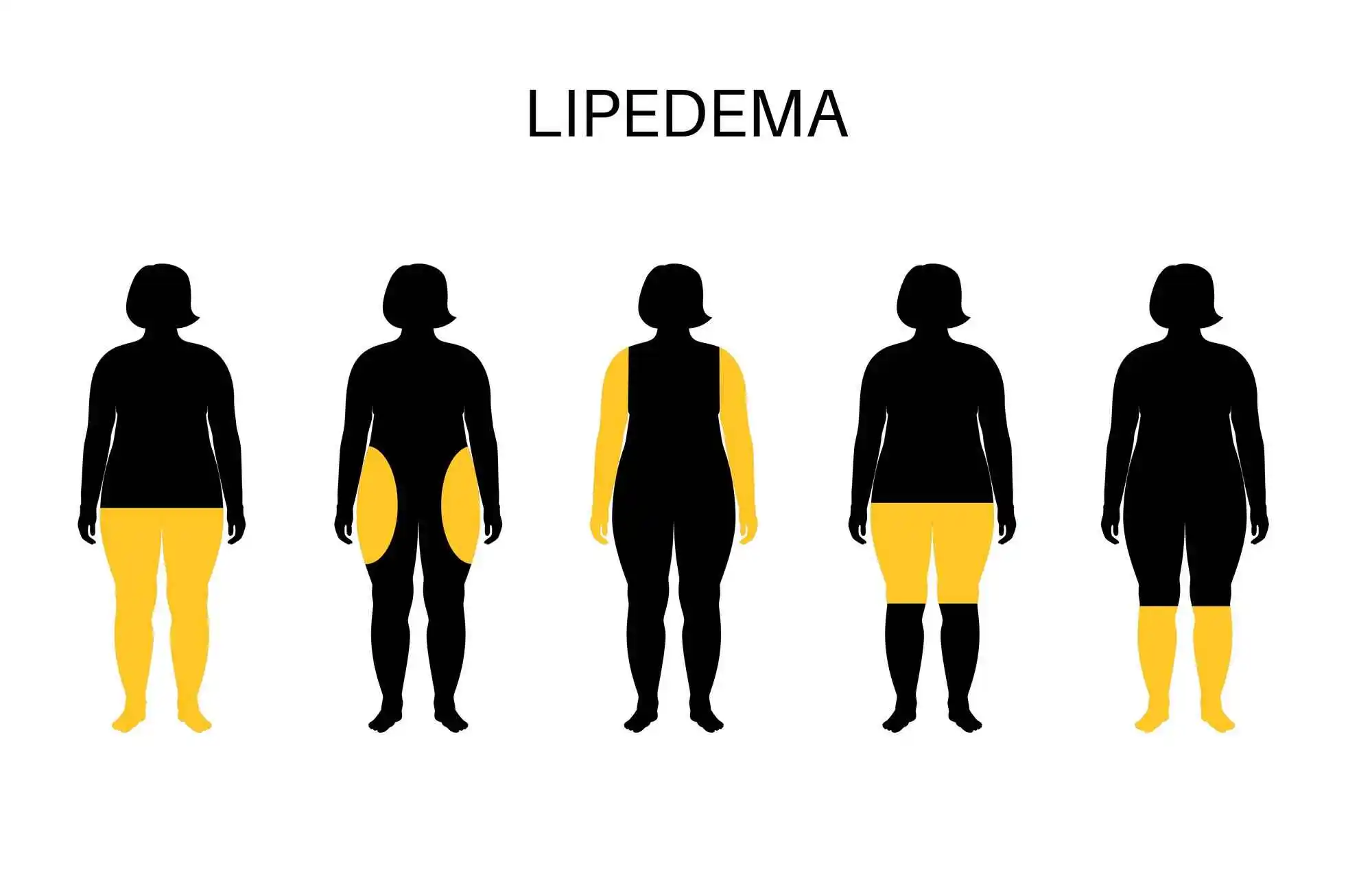Lipedema
An excessive accumulation of fat on each side of the lower body, mostly in your legs, is referred to as lipedema. It might be in your arms, though. It might be painful and interfere with day-to-day activities. Unlike regular fat, lipedema does not react to diet and exercise. Although lipedema cannot be cured, some therapies can improve your condition.
What is Lipedema?
Lipedema is a long-term disorder characterized by the abnormal accumulation of fat in the lower body. Most commonly, the butt, thighs, and calves are affected by lipedema. Some get it in their upper arms or hips. Your hands and feet are unaffected.
Although lipedema and lymphedema are two different diseases, people can mistake them for one another. But lymphedema can develop from lipedema. The body mass index (BMI) of many lipedema patients is greater than 35.
Diet and exercise can help you lose weight in the upper body without affecting the parts of the lower body that are impacted by lipedema.
Types of lipedema

- Type I: You are overweight between your hips and belly button.
- Type II: Excessive weight between the pelvis and knees.
- Type III: A fat deposit is found between the ankles and the pelvis.
- Type IV: You have fat in the space around your wrists and shoulders.
- Type V: Fat makes up the space between the ankles and knees.
How often does lipedema occur?
According to research, 1 in 72,000 persons suffer from lipedema. However, as lipedema can mimic fat or lymphedema, this figure is probably low. According to a different worldwide estimate, 11% of women suffer from lipedema. In males, the syndrome is uncommon.
Lipedema’s causes
Although the exact etiology of lipedema is unknown, potential factors include:
- Hormones. However, physicians believe that female hormones are involved. This is because the ailment primarily affects women and frequently starts or gets worse around adolescence, pregnancy, after gynecologic surgery, around menopause, or when taking birth control tablets.
- Genes. Because 20% to 60% of women with the disease have family members who also have it, scientists think genes play a role.
- Although lipedema is not caused by obesity, the majority of those who have it have a BMI above 35.
Symptoms of Lipedema
Common signs of lipedema include:
- Differences in leg and foot sizes. If you have lipedema, you will usually notice a size difference between your lower half and column-like legs and your feet, which are not impacted by the ailment. For instance, your physique may be a size 8 on the top half and a size 16 on the bottom half.
- Pain. Pain from lipedema may be present all the time or only when compression is applied. Additionally, your skin may bruise easily.
- Swelling and a heavy sensation. You can feel as though your legs are heavy and swollen.
- Accumulation of body fat. Your lower body becomes heavier as the disease worsens, and fat keeps accumulating. Later, fat may accumulate in the arms.
- Loose skin. The development of huge skin folds can be a consequence of lipedema.
- Bumps. You may feel as though something is beneath your skin due to bumps inside the fat.
- Fatigue. You can experience fatigue more frequently than usual if you have lipedema.
Why is fat from lipedema painful?
It’s still unclear how lipedema causes pain specifically. But according to some research, the nervous system may be triggered by hormones, inflammation, and excess material in the body between cells, which results in pain.
What are the lipedema risk factors?
Lipedema is more likely to occur if you:
- Being a woman.
- Have a family history of lipedema?
- Has a BMI greater than 35.
What are lipedema’s complications?
Lipedema may result in:
- Walking difficulties.
- feelings of anxiety and embarrassment
- Depression.
- A blockage in your lymphatic route that permits the accumulation of a fluid called lymph is known as secondary lymphedema or lipo-lymphedema.
- Disease of the veins.
- Flat feet.
- Joint problems.
- Your knees will bump against one another while your feet are apart.
Diagnosis and Tests
How is a diagnosis of lipedema made?
By performing a physical examination and gathering your medical history, a healthcare professional can make a diagnosis. Lipedema is caused by painful fat accumulation, as opposed to normal bodily fat, which is painless. Additionally, there is a noticeable size difference between the affected legs and the unaffected feet of persons with lipedema.
Which tests will be performed to identify lipedema?
A standardized test is not used by doctors to diagnose lipedema. However, they can use imaging and blood testing to rule out other problems or identify other disorders that might be causing your lipedema.
They could order the following tests:
- Ultrasound is a sound wave technology.
- DEXA scan, an X-ray diagnostic for bone density.
- Magnetic resonance imaging, also known as MRI, requires electromagnetic radiation, a computer, and a big magnet.
- Computed tomography (CT) is a computer-aided X-ray scan.
- Nuclear medicine imaging is a type of scan that uses an injected radioactive material to create images.
Stages of lipedema
Over time, lipedema gradually gets worse for many people. Stages of lipedema consist of:
- Stage 1: You feel as though there are pebbles beneath your skin, yet it appears normal. At this point, you may experience pain and bruises.
- Stage 2: The uneven area of your skin may be dimpled, which resembles a walnut shell, cottage cheese, or quilted stitching.
- Step 3: You may have big folds of skin and fat, and your legs may resemble inflated rectangular balloons. Walking may become difficult if fat on your legs protrudes.
- Stage 4: You have both lymphedema and lipedema simultaneously.
Treatment
How does one treat lipedema?
Lipedema treatments can enhance your quality of life by reducing pain and inflammation, even if there isn’t a solution at this time. For lipedema, you can begin with straightforward, noninvasive therapies and progress to more involved ones as necessary.
Simple treatments.
Treatment options for lipedema may include:
- Exercise. Walking, riding, and swimming all contribute to increased mobility and decreased edema. Additionally, tight joints are relieved by exercising in a pool.
- A diet that reduces inflammation.
- A heart-healthy diet. If you become aware of your lipedema early on, this could help slow its progression. However, unlike other types of fat, lipedema is typically not eliminated by dieting.
- Compression stockings.
- Skin moisturizer.
- Inflammation, edema, and other problems can be alleviated by medications or supplements (such as amphetamines, phentermine, metformin, resveratrol, diosmin, and selenium).
- Herbal medication with antioxidants.
Non-invasive treatments
Your doctor might recommend non-invasive lipedema therapies such as:
- Lymphatic drainage is a mild way to stretch and massage the skin.
- Complex decongestive therapy is followed by massages and compression wraps.
- A pneumatic compression device that you wear on your legs.
Invasive treatments
Liposuction can help with fat loss, pain, and mobility. Because wet-jet assisted liposuction is less likely to harm your lymph vessels than traditional liposuction, providers advise it.
Your doctor might suggest bariatric surgery if you have lipedema and a BMI of more than 35.
Treatment complications or adverse effects
Side effects are possible with every medication or herbal supplement. If any of your side effects are bothering you, speak with your provider.
The following are potential adverse effects of liposuction or bariatric surgery:
- Swelling.
- Bleeding.
- Infection.
- Thrombi.
What is the duration of recovery following therapy for lipedema?
The recovery period following liposuction may be four to six weeks. You will also require several weeks to recuperate following bariatric surgery. Following either treatment, you might need to refrain from physically demanding tasks for six weeks.
Prognosis
When I have lipedema, what can I expect?
For some people, lipedema develops over time, either slowly or suddenly. The symptoms of lipedema in some persons are modest and do not worsen.
With prompt diagnosis and treatment, you might be able to avoid problems. Compression stockings, along with exercise, can improve your results. Having liposuction can improve your mood.
Lipedema might worsen if you have other medical conditions like depression, obesity, or lymphedema. A healthcare professional may recommend physical therapy, psychotherapy, or pain management services.
Prevention
How can I reduce my chance of developing lipedema?
When the exact causes of lipedema are unknown, prevention becomes challenging. You can maintain a healthy weight even if you are a lady with a genetic history of lipedema. Discuss strategies for reaching your weight objectives with your healthcare professional.
FAQs
Is there a cure for lipedema?
An excessive accumulation of fat on either side of the lower body, especially the legs, is known as lipedema. It might be painful and interfere with day-to-day activities. Unlike regular fat, lipedema does not react to diet and exercise. Although lipedema cannot be cured, some therapies can improve your condition.
Describe lipedema fat.
The structure and behavior of lipedema fat differ from those of normal fat. Excessive, uncomfortable, and irregular amounts of fat in the upper body and legs are often its defining features.
What causes lipedema?
Lipedema’s precise cause is unknown. You could inherit the disease, though, as it runs in families in between 20% and 60% of instances. Nearly all cases of the illness are in women. Given that lipedema typically begins or worsens during puberty, pregnancy, and menopause, it may be hormone-related.
What are the symptoms of lipedema in women?
The chronic ailment known as lipedema, which primarily affects the lower body, is more common among women. Often, lipedema is mistaken for either lymphedema or normal fat. At first, it could appear to be a cosmetic issue, but with time, it can lead to pain and other problems.
How can I treat lipoedema, and what is it?
The term “lipoedema” refers to an abnormal accumulation of fat in the arms and legs. There are several things you may do that can help, but it can be painful and interfere with day-to-day living. Women are more likely to have lipoedema. Both sides of the body are often equally affected.
What phases does lipedema go through?
Swelling can be minimal. Lipedema is categorized according to stage: Stage 1: The hypodermis (lipedema fat) is increased on the normal skin surface. Stage 2: Uneven skin with bigger hypodermal lumps (lipomas) and fat indentations. Stage 3: Bulky skin and fat extrusions generate significant deformations, especially on the thighs and around the knees.ky skin and fat extrusions.
Reference
- Lipedema. (2025, June 2). Cleveland Clinic. https://my.clevelandclinic.org/health/diseases/17175-lipedema
- What is lipedema? (2023, December 26). WebMD. https://www.webmd.com/women/lipedema-symptoms-treatment-causes
- Chandem. (2025, March 29). A Comprehensive Guide to Lipedema: Types, Causes, Symptoms, Stages, Treatments, & Prevention. Salameh LippyLipo. https://salamehplasticsurgery.com/comprehensive-guide-to-lipedema/





One Comment